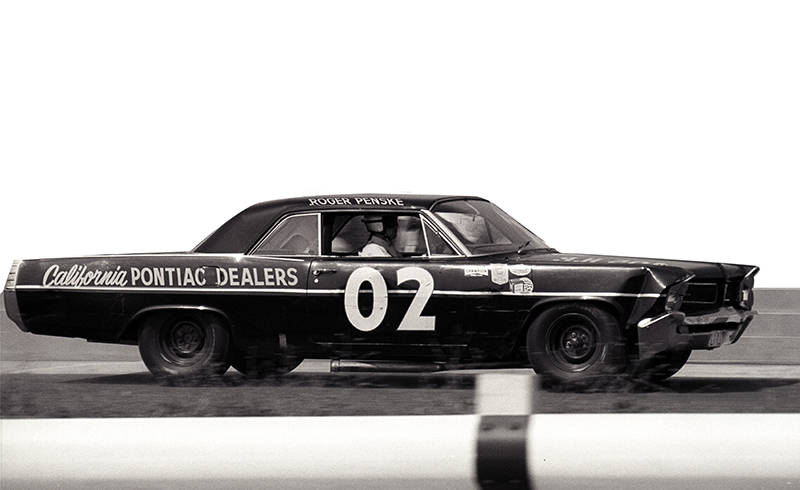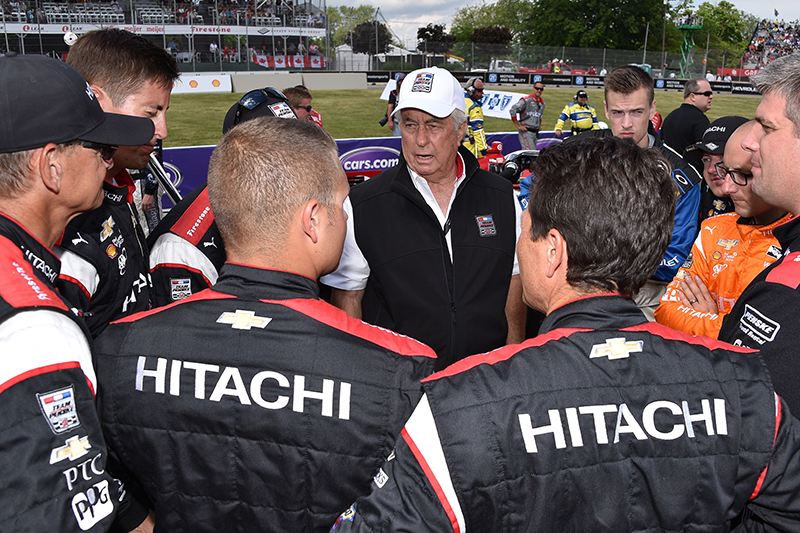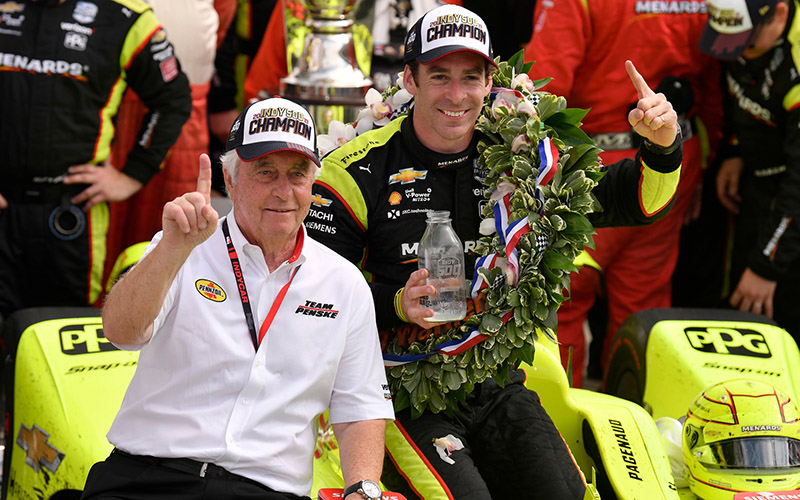
After a business career that’s spanned more than 60 years and has made him an automotive industry titan and a racing legend, Roger Penske doesn’t get ruffled easily. But after acquiring arguably the most famous racetrack in the world, the Indianapolis Motor Speedway, Penske found himself in an unfamiliar position.
“I was shaking like a leaf,” Penske admits about making the traditional track owner’s call to start the engines at the beginning of the Indianapolis 500 in May. “When you see all the pageantry and you stand there to say, ‘Drivers, start your engines,’ you ask, What have I gotten myself into?”
Some of the emotions coursing through his veins had to do with welcoming fans to the hallowed Brickyard for the first time since he bought the racetrack in late 2019.
“For me, having had a year to prepare (due to COVID-19), and then to have two or three times as many people as you have at a Super Bowl (350,000-person capacity), and be able to execute the way we have, I have to say the team did an outstanding job, and the feedback is off the charts.”
 From his motorcoach at the Chevrolet Detroit Grand Prix in June, Penske — called The Captain by his early pit crews because he managed his race teams with military precision — reflected on his acquisition of the famed Indianapolis Speedway, the Indianapolis 500 race itself, the Brickyard 400 NASCAR race, the NTT IndyCar Series, and IMS Productions. The previous owners, the Hulman family, had operated the track for more than 70 years.
From his motorcoach at the Chevrolet Detroit Grand Prix in June, Penske — called The Captain by his early pit crews because he managed his race teams with military precision — reflected on his acquisition of the famed Indianapolis Speedway, the Indianapolis 500 race itself, the Brickyard 400 NASCAR race, the NTT IndyCar Series, and IMS Productions. The previous owners, the Hulman family, had operated the track for more than 70 years.
“When he purchased IndyCar, no (team) owner moaned about a potential conflict of interest,” says Bob Pockrass, FOX Sports’ NASCAR reporter and a longtime observer of the racing world. “They know he’ll treat everyone professionally and fairly. They trust that he’ll look out for the sport and the speedway as a whole. His love of the facility and his professional approach to business will guide him.”
Indianapolis isn’t Penske’s first foray into racetrack ownership. Between 1972 and 2007, he owned, at various times, the Michigan International Speedway in the Irish Hills of Brooklyn, Mich., Nazareth Speedway in Pennsylvania, and North Carolina Speedway in Rockingham, and he built California Speedway, now Auto Club Speedway, in Fontana, Calif.
Although the Indianapolis racetrack has been upgraded several times over its 111-year lifetime, including as recently as 2016 for the 100th running of the Indy 500, observers were interested to see what improvements Penske would make. They didn’t have to wait long. Shortly after he took possession of the track in January 2020, Penske announced several projects, all slated to be completed by May 2020, when teams and fans were scheduled to arrive for the 104th running of the “Greatest Spectacle in Racing.” But the race was postponed until Aug. 23, 2020, due to the COVID-19 pandemic, and was run without fans in the stands.

“The month of May at IMS is my favorite time of year and, like our fans, I’m disappointed we had to reschedule the Indy 500,” Penske said in a statement when the 2020 race was delayed. “We’re going to double down on the customer experience in the months ahead and I’m confident we’ll greet fans with a transformed facility and a world-class spectacle.”
It took until May 2021 before the racing faithful were able to see the improvements Penske made to the Brickyard, which included:
• Improved seating
• Twenty new video boards
• A new media wall in Pagoda Plaza
• 5G cellular data connectivity
• New entry points
• Paved parking lots
• Renovated restrooms with added amenities
• 25,000 square feet of new fencing
• An elevated victory lane platform so spectators can see the winner’s celebration
“If he wants something done, he doesn’t want to know why it can’t be done. He wants to know how to make it happen, and then come up with a plan to achieve it,” Pockrass says. “Having run racetracks and race teams, he understands the challenges both face and how they can work together to be part of the solution.”
Penske himself said in January 2020, when announcing his plans for track upgrades: “When you see some of the things we’re going to accomplish before the race, believe me, this is really starting to write a new book from the standpoint of what we can do here as we go forward.”
Dan Assenmacher of Bloomfield Hills, a longtime race fan and a former senior account executive at BorgWarner, which sponsors the trophy that goes to the winner of the Indy 500, has spent numerous Memorial Day weekends at Indy and thought Penske’s purchase of the track was a positive move.
“The Hulman family did great things to bring the track back from disrepair after World War II to the hallowed racing ground it is today,” Assenmacher says. “Time, however, continues to take its toll on the track, and I think Penske truly understands what needs to be done to IMS to take it to the next level for both the drivers and fans.”
In addition to physical upgrades, Penske has added new sponsors — Pennzoil, Verizon, Snap-On Tools, Road & Track magazine, Global Medical Response, and DEX Imaging — to the Speedway, the 500-mile race, and the NTT IndyCar Series. That additional revenue allowed Penske to increase the total Indy 500 purse to more than $8.8 million, with close to $2 million going to the winner.
In an ironic twist, former Penske driver Helio Castroneves took home $1.8 million when he won his fourth Indy 500 on May 30.
“We’re investing in the track but also trying to provide additional monies to the teams that are successful here,” says Penske, 84.
Like all of his businesses, Penske wants to grow the Indianapolis Motor Speedway. He envisions a year-round entertainment venue that can host business conferences, meetings, and outdoor concerts. “We’ll continue to invest, to make it better,” Penske says. “Every time I go there, I find something else that we can make better.”
As far as plans for the future are concerned, nothing has been announced, but a company spokesman says further improvements for fans and enhancements of their experience at the speedway can be expected.
The Penske journey began with his birth in Shaker Heights, a suburb of Cleveland, in 1937. As a teenager, he bought old cars, repaired them, and sold them at a profit. He studied business administration, and in 1959 graduated from Lehigh University in Bethlehem, Pa., and started racing cars.

By 1960, Sports Illustrated named him the Sports Car Club of America Driver of the Year. Among his accomplishments as a driver were 55 race victories, competing in two Formula 1 Grand Prix races, and being named North American Driver of the Year by The New York Times and The Los Angeles Times.
Penske retired from the cockpit in 1965 to focus on his first car dealership, a Chevrolet store in Philadelphia. Banks and insurance companies didn’t want to back him if he was driving race cars.
“It was a business decision, and it wasn’t a hard one because I felt, longer term, I could build a business and have a race team, and that’s exactly how it evolved,” Penske told former NASCAR driver Kyle Petty on his YouTube feature, “Coffee with Kyle” in 2019.
In 1966, Penske made his debut as a race car owner at the 24 Hours of Daytona. With his driver, Mark Donohue, they made their first start in the Indianapolis 500 in 1969. His first of 18 open wheel conquests of the Brickyard as an owner came in 1972. The pair’s first NASCAR win came in 1973. Tragically, Donohue died a few days after a crash during practice for the 1975 Austrian Grand Prix.
Since then, some of the greatest drivers in the history of motorsports have driven for Team Penske, including Mario Andretti, Bobby Unser, Bobby Allison, Rusty Wallace, Al Unser, Al Unser Jr., Emerson Fittipaldi, Rick Mears, Tom Sneva, Danny Sullivan, and Castroneves. His current IndyCar stable includes Josef Newgarden, Simon Pagenaud, Will Power, and Scott McLaughlin. Rochester Hills native Brad Keselowski, Joey Logano, and young gun Ryan Blaney pilot the Captain’s current NASCAR fleet.
“Growing up in the sport, I always appreciated the team and Roger in particular,” says Blaney, a third-generation racer who joined Team Penske as a 19-year-old in 2012. “I didn’t meet him until I decided to sign with the team. It was pretty intimidating at first, but at the end of the day he’s an extremely kind person with a killer attitude, sometimes, but I think you’ve got to have that to be as successful as he’s been over the years.
“It’s been great to get to know him and learn from him,” Blaney continues. “He’s a great human being and it’s been a pleasure to drive for him and more of a pleasure to get to know him as a person. His work ethic is pretty amazing, with all he does at his age. It’s mind-blowing.”
Team Penske’s entire racing operation is headquartered in a 424,000-square-foot complex on 105 acres in Mooresville, N.C.
“Just walk through the Penske shop and see how well things are run, operated, and organized and that’s how he runs his businesses,” Blaney says. “It makes you see the bigger picture. It’s no wonder why he’s successful in everything he touches. He takes that pride in everything he does — not just his race teams, but his dealerships and other business ventures.”
The key to Penske’s success in business and in racing, according to observers, is that aforementioned attention to detail. One example is the “tile guy” at the Team Penske race shop.
“There’s a dedicated tile guy at Penske,” Blaney explains. “The whole race shop floor is tile. If one gets cracked, it’s getting fixed before the end of the day. A cracked tile looks bad and that’s not acceptable.”

While racing is Penske’s most visible enterprise, he’s also chairman of Penske Corp. in Bloomfield Township. Penske Corp. includes the Penske Automotive Group, featuring more than 300 automotive franchises in nine countries on four continents, the Penske Motor Group of four dealerships in California and Texas, and Penske Truck Leasing, which operates more than 330,000 vehicles and serves customers from more than 3,000 locations in North America, South America, Europe, Australia, and Asia.
“We run the racing business like we run our other businesses,” Penske says. “It’s all about the people, delegation, and low turnover. There are people with a lot of experience in the company. We have a flat organization. There are people here (at the race) today that execute in our business and vice versa. We want to bring people in at the entry level, (and) let them grow with the organization. It’s hard to get in and hard to leave.”
Edsel B. Ford II, a former member of the Ford Motor Co. board of directors, says Penske has been a positive force in the business community for decades, “whether it has been his dealerships, his transportation companies, his manufacturing, and certainly in the motor racing industry. He’s a strategic thinker who has been able to successfully oversee businesses all over the world, while maintaining his personal touch and influence in all of them.”
According to Penske, the racing and nonracing elements of his empire work hand in hand.
“I think you need to have something within your brand that shows you can win,” he says. “The people that work for you, that’s what we built our whole company on. Racing is a common thread throughout the company. And that performance and winning certainly has helped us, not only internally but externally.”
With his large contingent of dealerships in the U.S. and abroad, Penske is paying close attention to the focus automakers are putting on electrification.
“I don’t think you’re going to see the world going all electric by 2030,” he predicts. “You’ll see a lot of hybrid solutions in all sorts of transportation. There might be mandatory electrification in certain cities and high-density populated areas.”
He says the demand for EVs in Europe is stronger than in the U.S. because many high-density population centers overseas are mandating electrification.
“Demand is building, but infrastructure is critical in order to make that happen,” Penske says. “We’re looking at it in our truck business, but I don’t see it moving to 10 percent or 15 percent of the market overnight.”
He says his organization is looking at electrification in the future strategically — specifically, what the dealerships are going to need to have parts and be able to service the machines. “With 300 million vehicles (in the world), you start looking if there’s a 5 percent or 10 percent compounded annual growth rate. It’s going to take quite a while before the ICE (internal combustion engine) would be out.”
While he has become an icon in racing and in business, he hasn’t forgotten his adopted home of the metro Detroit community.
In 2006, he chaired the Host Committee for Super Bowl XL. A year later, and again in 2012, he spearheaded the effort to bring the Detroit Grand Prix back to Belle Isle. In 2014, Penske contributed $10 million to help shelter the treasures of the Detroit Institute of Arts during Detroit’s Chapter 9 bankruptcy. Last year, Penske Corp. donated $5 million to revitalize the Lenox Community Center and the park in which it is located in the Jefferson Chalmers neighborhood on Detroit’s far east side.
“It’s where I live,” Penske explains about his devotion to the Motor City. “We’re automotive-related. We became a dealer here with Chevrolet back in 1965, and I guess ever since then we’ve focused on the automobile business.
“We’ve got to give back. And the way to give back probably started in 2002, when we were asked to head up the Super Bowl. Once we got connected there, it’s hard to leave and people asked us what we’re going to do next. Part of that happened to be getting together with General Motors Co. and Mark Reuss (president of GM) and bringing racing back to Detroit. We made a huge investment here (paving) the paddock.”

In addition, Penske has been active in the Downtown Detroit Partnership and the Clean Downtown Initiative. He also was a driving force behind Detroit’s QLine modern streetcar, and the successful effort to raise $8 million in private funding for new police and EMS vehicles.
“Roger’s commitment to Detroit has been unwavering, and it’s one of the things people admire about him,” Ford says. “Whether it was leading the effort to bring a Super Bowl here, helping rebuild and revitalize Belle Isle through capital improvements brought about through the Detroit Grand Prix, or numerous other business and charitable efforts, Roger is always one of the first to step up to help when the Detroit area needs it.”
But it has been in motorsports where Penske has achieved the most visible success and fame that has resulted in numerous honors, including inductions into five motorsports-related halls of fame, the 2017 Horatio Alger Award and, in 2019, the Presidential Medal of Freedom from President Donald Trump.
Over the past 55 years, Team Penske has won more than 590 individual races including victories in the 24 Hours of Daytona and the 12 Hours of Sebring, 650-plus pole positions, 16 IndyCar championships, 18 Indianapolis 500s, a pair of NASCAR Cup Series titles, two Daytona 500s, a Brickyard 400, three Australian Supercars championships, and five NASCAR Xfinity Series titles.
“I think it’s safe to say that he could be considered the most successful team owner in motor racing history, and what’s impressive is that he has been able to be successful in so many different forms of the sport,” Ford says. “We feel fortunate that his team is a major part of our NASCAR effort. Roger approaches motor racing with the same intensity and passion he does with all his business efforts.”












